Who are the Tamil Tigers .. and how important are they in the real war on terrorism?
Aug 25th, 2006 | By Counterweights Editors | Category: Countries of the World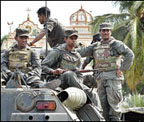 This week, on August 23, under the intriguing headline “TAMILS SAID THEY WERE GOING TO STAG PARTY,” the Toronto Globe and Mail cast some light on a current brand of alleged international terrorism that does not involve Islamist fantasies, Al-Qaida, or the Middle East. Here as elsewhere, Canada has distinguished itself from the elephant next door. It has somewhat more to do with the matter than the United States – along with, e.g., India, the United Kingdom, and Norway (“Land of Giants“). But you do have to wonder, a bit: is fighting the Tamil Tigers in Sri Lanka quite so aggressively really a wise expenditure of hard-earned Canadian tax dollars?
This week, on August 23, under the intriguing headline “TAMILS SAID THEY WERE GOING TO STAG PARTY,” the Toronto Globe and Mail cast some light on a current brand of alleged international terrorism that does not involve Islamist fantasies, Al-Qaida, or the Middle East. Here as elsewhere, Canada has distinguished itself from the elephant next door. It has somewhat more to do with the matter than the United States – along with, e.g., India, the United Kingdom, and Norway (“Land of Giants“). But you do have to wonder, a bit: is fighting the Tamil Tigers in Sri Lanka quite so aggressively really a wise expenditure of hard-earned Canadian tax dollars?
Recent arrests of Canadian (and American) Tamils … and a new round of fighting (even civil war?) in Sri Lanka …
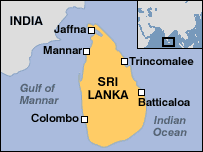 The immediate news here is that, as part of a joint RCMP-FBI investigation, three “Canadian Tamils” were arrested in New York on August 19. They allegedly conspired to purchase “$900,000 (U.S.) worth of weaponry from shady arms dealers in New York City” – for “the Liberation Tigers of Tamil Eelam, or Tamil Tigers, who have been waging a two-decade battle for a separate homeland” in northern and eastern Sri Lanka (just off the southeast coast of India).
The immediate news here is that, as part of a joint RCMP-FBI investigation, three “Canadian Tamils” were arrested in New York on August 19. They allegedly conspired to purchase “$900,000 (U.S.) worth of weaponry from shady arms dealers in New York City” – for “the Liberation Tigers of Tamil Eelam, or Tamil Tigers, who have been waging a two-decade battle for a separate homeland” in northern and eastern Sri Lanka (just off the southeast coast of India).
An additional two Canadian Tamils were arrested in Ontario, on August 21 and 23. They are “engineering and computer science students” who “allegedly kept in contact with top Tamil Tiger operatives in Sri Lanka and the United States, and worked to obtain … compasses, computers and night-vision goggles … aviation equipment, submarine and warship design software, and communications equipment’ for the Tamil Tigers.”
These two sets of arrests are apparently related. And it was the Canadian Tamil suspects in the supposed shady New York City arms deal who, when they crossed the Canada-US border, told officials that they were going to a stag party in Buffalo. But they are “most of them professionals in their mid-20s” who “walked into a sting … The arms dealers they spoke to were working for the U.S. Federal Bureau of Investigation.”
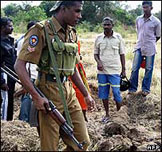 The Globe and Mail tells us as well: “In a related sting also announced this week, the FBI arrested seven American Tamils and accused them of trying to bribe U.S. State Department officials into lifting the terrorist ban on the Tigers. While the group’s tactics include suicide bombings and assassination, the Tigers still garner sympathy from Tamils who have fled the fighting in their Indian Ocean homeland.”
The Globe and Mail tells us as well: “In a related sting also announced this week, the FBI arrested seven American Tamils and accused them of trying to bribe U.S. State Department officials into lifting the terrorist ban on the Tigers. While the group’s tactics include suicide bombings and assassination, the Tigers still garner sympathy from Tamils who have fled the fighting in their Indian Ocean homeland.”
Finally, on August 23 the Globe and Mail also reported that: “The Red Cross said … it would dispatch a ferry to northern Sri Lanka to evacuate foreigners amid fierce fighting, as activists expressed alarm over a Catholic priest who disappeared after witnessing disputed deaths …
“The [Sri Lankan] military meanwhile said security forces and the Tamil Tiger rebel group traded fire on two fronts overnight, in the northern peninsula of Jaffna and in eastern Sri Lanka … The ferry will pick up international aid workers and other foreign passport holders trapped in Jaffna Peninsula by a recent escalation of fighting between government troops and the rebels … .”
Canada and the Sri Lankan Tamils …
 Canadians at least ought to be able to understand the current troubles in Sri Lanka a little better than most others. In principle at least the situation of the Tamils there is (very) broadly and crudely comparable to the situation of the Quebecois in Canada.
Canadians at least ought to be able to understand the current troubles in Sri Lanka a little better than most others. In principle at least the situation of the Tamils there is (very) broadly and crudely comparable to the situation of the Quebecois in Canada.
There are of course some crucial differences in practice. The Parti Quebecois (PQ) and the Bloc Quebecois (BQ), e.g., are quite different political animals from the Liberation Tigers of Tamil Eelam (LTTE). Even allowing for the October 1970 crisis, the Canadian federal government has never been (and is not even now) quite as military-minded as the government of Sri Lanka.
Similarly, Sri Lanka has never had a Tamil prime minister, or president, the way Canada has had such French Canadian prime ministers from Quebec as Wilfrid Laurier, Louis St. Laurent, Pierre Trudeau, and Jean Chretien. And there is no such thing as a unique provincial government of Eelam in Sri Lanka, as there most certainly nowadays is a unique provincial government of Quebec in Canada, with its own “National Assembly.”
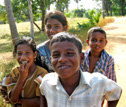 Canada today has another kind of special relationship with Sri Lanka too. Trouble for Tamils in Sri Lanka over the past few decades has stimulated migrations of Sri Lankan Tamils to other parts of the world. According to one spring 2006 Canadian newspaper report, nowadays “Canada has the world’s largest Sri Lankan Tamil diaspora, estimated at 250,000.”
Canada today has another kind of special relationship with Sri Lanka too. Trouble for Tamils in Sri Lanka over the past few decades has stimulated migrations of Sri Lankan Tamils to other parts of the world. According to one spring 2006 Canadian newspaper report, nowadays “Canada has the world’s largest Sri Lankan Tamil diaspora, estimated at 250,000.”
The Globe and Mail itself has more recently claimed that “an exodus of refugees … caused Canada’s Tamil population to swell to 300,000. Most are concentrated in the Greater Toronto Area, which claims to have the largest concentration of Tamils outside Sri Lanka.”
At the same time, as urged on a website called tamiltigers.net: “According to the 2001 census there are” only “92,010 Tamil Canadians … Media estimates of 150,000 to 200,000 Tamil Canadians” are “an over inflated figure.” On this calculation India has the largest “Sri Lankan Tamil” diaspora. But Canada still has the second-largest such group in the global village. And Canadian Tamils significantly outnumber, e.g., the estimated 24,600 “American Tamils” in the USA today.
Just what is going on in Sri Lanka anyway … ?
 As a BBC News “Sri Lanka timeline” illustrates, the largely “secular-Hindu” Tamil minority, concentrated in northern and eastern Sri Lanka, has complained about its status ever since what was then called Ceylon gained independence from the old British Raj in 1948. The Tamils have long felt that the country’s Sinhalese (and Buddhist) majority systematically excludes them.
As a BBC News “Sri Lanka timeline” illustrates, the largely “secular-Hindu” Tamil minority, concentrated in northern and eastern Sri Lanka, has complained about its status ever since what was then called Ceylon gained independence from the old British Raj in 1948. The Tamils have long felt that the country’s Sinhalese (and Buddhist) majority systematically excludes them.
Just quoting quickly from the BBC timeline: In 1949 “Indian Tamil plantation workers” were “disenfranchised.” In 1972 “Ceylon” changed “its name to Sri Lanka and Buddhism” was “given primary place” as the “country’s religion, further antagonising” the “Tamil minority.” In 1976 the “Liberation Tigers of Tamil Eelam (LTTE) formed as tensions” increased “in Tamil-dominated areas” of the north and east.” In 1977 the “Separatist Tamil United Liberation Front (TULF) party” won “all seats in Tamil areas” in the elected Sri Lankan legisalture.
Intriguingly enough, 1976 was also the year when the Parti Quebecois won its first provincial election in Quebec. But the Tamil United Liberation Front would never have quite such an opportunity in Sri Lanka. By the mid 1980s the struggle there had fallen into a violent armed conflict, between the Liberation Tigers of Tamil Eelam and the Sri Lankan army.
(Taken with various grains of salt, you might almost say that Sri Lanka suggests what might have happened in Canada, if Quebecois and Canadians had decided to resolve their differences with guns instead of the ballot box, in provincial and federal elections and, of course, referendums.)
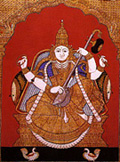 There was some moderation of the conflict between the LTTE and the Sri Lankan army in the later 1980s. In 1987 “Government forces” pushed the “LTTE back into” the “northern city of Jaffna.” The Sri Lankan government signed “accords creating new councils for Tamil areas” and reached “agreement with India on deployment of” an “Indian peace-keeping force.”
There was some moderation of the conflict between the LTTE and the Sri Lankan army in the later 1980s. In 1987 “Government forces” pushed the “LTTE back into” the “northern city of Jaffna.” The Sri Lankan government signed “accords creating new councils for Tamil areas” and reached “agreement with India on deployment of” an “Indian peace-keeping force.”
Alas, this proved illusory, and gave way to a more intense armed struggle in the 1990s. By the year 2000 the bloodshed had grown appallingly. Many involved (and some in the wider international community) felt an increasingly urgent need to change directions. The events of September11, 2001 in the United States may have helped stiffen this mood.
In February 2002 the Sri Lankan “Government and Tamil Tiger rebels” signed “a permanent ceasefire agreement, paving the way for talks to end the long-running conflict.” The 2002 “peace initiative” was “sponsored by Norway.” It more or less lasted until this year. Then, perhaps partly in sympathy with some kind of larger global vibrations now afoot, the ceasefire agreement began to fall apart again in the spring of 2006.
By the present juncture in August 2006, as the BBC timeline puts it, “Tamil Tiger rebels and government forces” have clashed “in the north-east”of Sri Lanka – in “the worst fighting since the 2002 ceasefire. Hundreds of people” have been “killed and the UN says tens of thousands have fled their homes.”
What kind of terrorists are the Tamil Tigers … ?
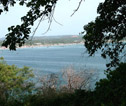 Just on the face of things, you might wonder why the world outside Sri Lanka itself should be so concerned about the Tamil Tigers. According to the Council on Foreign Relations in the US: “In its early days, experts say, the LTTE trained with the Palestine Liberation Organization.” But even if this is true (or half-true), Tamils are for the most part Hindus, not Muslims or Christians, and the Tamil Tigers have no great interests in politics beyond the borders of Sri Lanka.
Just on the face of things, you might wonder why the world outside Sri Lanka itself should be so concerned about the Tamil Tigers. According to the Council on Foreign Relations in the US: “In its early days, experts say, the LTTE trained with the Palestine Liberation Organization.” But even if this is true (or half-true), Tamils are for the most part Hindus, not Muslims or Christians, and the Tamil Tigers have no great interests in politics beyond the borders of Sri Lanka.
Beyond some vague long-ago and perhaps even just apocryphal training period with the PLO, the Tigers have no essential or direct connections at all with 9/11, Jihad, Al-Qaida, Islamist terrorism, or the current swamp of armed and other conflict in the Middle East. They have perpetrated no acts of violence outside Sri Lanka – or at most (and only intermittently) beyond India and the adjacent Indian Ocean.
Yet the United States declared the Tamil Tigers an illegal terrorist organization as early as 1997. The United Kingdom followed suit in 2001. And earlier this year, in 2006, both Canada and the European Union joined the same club.
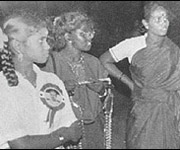 The case against the Tigers is that even if their political ends are limited, they have developed into highly artful and “fearsome” practitioners of the most aggressive contemporary terrorist means. As explained on GlobalSecurity.org: “The LTTE has integrated a battlefield insurgent strategy with a terrorist program that targets key government and military personnel, the economy, and public infrastructure …
The case against the Tigers is that even if their political ends are limited, they have developed into highly artful and “fearsome” practitioners of the most aggressive contemporary terrorist means. As explained on GlobalSecurity.org: “The LTTE has integrated a battlefield insurgent strategy with a terrorist program that targets key government and military personnel, the economy, and public infrastructure …
“Political assassinations include the suicide bomber attacks against Sri Lankan President Ranasinghe Premadasa in 1993 and Indian Prime Minister Rajiv Gandhi in 1991, which is the group’s only known act outside Sri Lanka. The LTTE has detonated two massive truck bombs directed against the Sri Lankan economy, one at the Central Bank in January 1996 and another at the Colombo World Trade Center in October 1997. [Colombo is the capital city of Sri Lanka.] The LTTE also has attacked several ships in Sri Lankan waters, including foreign commercial vessels and infrastructure targets such as commuter trains, buses, oil tanks, and power stations.”
In particular, it seems that the Tigers have developed the terrorist tactic of suicide bombing into a very fine art. According to one security analyst, e.g., even though they are an “adamantly secular group with Hindu roots, the Tamil Tigers” have become “the leading purveyors of suicide attacks over the last two decades – until now.”
How much money should Canada (or the United States?) actually be spending on fighting the Tamil Tigers … ?
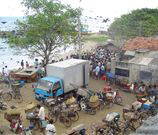 In such places as Canada (or the United States and so forth), to brand the Tigers as an illegal terrorist organization is to take an essentially technical or even technological definition of terrorism. You are a political terrorist (or an illegal terrorist organization), and thus beyond the protections of the ordinary rule of law, if you use (or even just sanction?) any form of deadly force – and especially suicide or any other form of bombing – against random innocent populations, to achieve political objectives anywhere in the world.
In such places as Canada (or the United States and so forth), to brand the Tigers as an illegal terrorist organization is to take an essentially technical or even technological definition of terrorism. You are a political terrorist (or an illegal terrorist organization), and thus beyond the protections of the ordinary rule of law, if you use (or even just sanction?) any form of deadly force – and especially suicide or any other form of bombing – against random innocent populations, to achieve political objectives anywhere in the world.
This kind of, as it were, politically neutral technical definition of terrorism is bound to appeal to security agencies in free and democratic countries – and so no doubt it should. But something that make sense analytically in this context is not necessarily something that also instantly translates into wise and prudent public policy.
Canada, e.g., has only this year classified the LTTE as an illegal terrorist organization, under the guidance of Stephen Harper’s new Conservative minority government in Ottawa (which has also, it seems fair enough to say, somewhat stiffened the current Canadian role fighting the Taliban in Afghanistan as well). And whether it finally makes much practical sense for a country like Canada (or again even the United States) to spend any significant chunk of hard-earner taxpayer dollars fighting or otherwise countervailing a terrorist organization like the Tamil Tigers remains a fair enough question for continuing public debate.
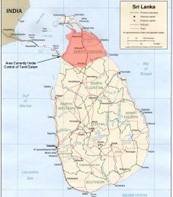 It no doubt does make sense for Canada, e.g., to spend some significant public funds fighting or otherwise countervailing Islamist or other authentically “international” terrorist organizations – because they have clearly enough indicated their desire and intention (however fantastic) to destroy the free and democratic society that the overwhelming majority of Canadians enjoy and support today. But the LTTE in Sri Lanka has never indicated any such desire or intention.
It no doubt does make sense for Canada, e.g., to spend some significant public funds fighting or otherwise countervailing Islamist or other authentically “international” terrorist organizations – because they have clearly enough indicated their desire and intention (however fantastic) to destroy the free and democratic society that the overwhelming majority of Canadians enjoy and support today. But the LTTE in Sri Lanka has never indicated any such desire or intention.
In fact the now longstanding troubles in Sri Lanka to which the Tamil Tigers are a party are no less and no more than a civil war – which has tragically enough, it seems, now begun to fester again after a few more benign years of ceasefire. The LTTE actually controls a small but significant enough chunk of territory in the north of Sri Lanka, while the government of Sri Lanka, dominated by the country’s Sinhalese and Buddhist majority, controls the rest. How much money does Canada really want to spend on what finally amounts to intervening in a civil war in Sri Lanka, on behalf of the current Sri Lankan government?
Many security analysts do seem to urge that the technical or even technological terrorist success of the Tamil Tigers has a kind of highly lamentable indirect demonstration affect on, or serves as an inspiration for, e.g., Islamist terrorists in the Middle East. In Canada you might even conceivably raise the prospect that the Tigers, if they ever are ultimately successful in achieving some kind of unique Tamil Eelam political entity in Sri Lanka, could prove a very bad example for the sovereigntist movement in Quebec.
But this only again raises the point that the Quebecois already have some kind of unique Quebecois political entity in the government of the Canadian province of Quebec, which has its own National Assembly, etc. The Tamil Tigers might easily say that they are doing what they are doing because even this is not possible in Sri Lanka today. And in this context a Canadian might even say that in declaring the Tigers illegal in Canada, the government of Canada is finally helping the government of Sri Lanka achieve ultimate objectives which the government of Canada has itself forgeone in Canada, because it quite properly believes that military force is not how you finally resolve political problems inside a free and democratic society.
 Similarly, security analysts stress as well that: “The LTTE exploits large Tamil communities in North America, Europe, and Asia to obtain funds and supplies for its fighters in Sri Lanka. The Liberation Tigers of Tamil Eelam are involved in numerous trans national criminal activities, including partnerships with Pakistani heroin producers/traffickers, alien smuggling, extortion from Tamil families living abroad, and various forms of fraud. All this in order to raise funds for their insurgent activities in Sri Lanka.”
Similarly, security analysts stress as well that: “The LTTE exploits large Tamil communities in North America, Europe, and Asia to obtain funds and supplies for its fighters in Sri Lanka. The Liberation Tigers of Tamil Eelam are involved in numerous trans national criminal activities, including partnerships with Pakistani heroin producers/traffickers, alien smuggling, extortion from Tamil families living abroad, and various forms of fraud. All this in order to raise funds for their insurgent activities in Sri Lanka.”
There have also been reports in the Canadian media lately – in the press and on TV – about allegations of Tamil Tiger extortion of Canadian Tamils in the LTTE’s North American fund-raising activity. These would be more compelling, however, if they came from obviously Canadian Tamils rather than obviously Canadian Anglo journalists and security analysts.
An August 24 report in the Toronto Globe and Mail added a related note of caution. The LTTE’s finely wrought suicide bombing and parallel terrorist tactics “have earned the Tigers much international condemnation. Yet, just as many expatriate Irish have long supported the Irish Republican Army, the Tamil diaspora largely supports its separatist fighters, or at least their goal of separating from the rest of Sri Lanka, which is dominated by the Sinhalese ethnic group.”
A Postscript on the State of Tamil Nadu in India …
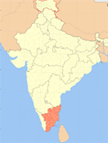 As a very quick final note in an already too long burst here, it is also worth underlining that the current troubles of Tamils in Sri Lanka do not exhaust the larger question of Tamil peoples and their fate in the wider global village today.
As a very quick final note in an already too long burst here, it is also worth underlining that the current troubles of Tamils in Sri Lanka do not exhaust the larger question of Tamil peoples and their fate in the wider global village today.
On a calculation from the late 1990s, there “are an estimated 74 million Tamils around the world.” Only 3,600,000 are in Sri Lanka. The vast majority – some 63,000,000 – are in India, and concentrated in the southern Indian state of Tamil Nadu, immediately adjacent to the island of Sri Lanka.
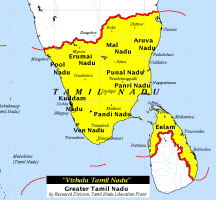 On August 17, 2006 the Tamil Nadu state assembly “unanimously passed a resolution condemning the killing of 61 school girls in Sri Lanka’s north by air force jets [of the Sri Lankan government] apparently targeting the Tamil Tigers …The resolution termed the mass killings ‘uncivilized, barbaric, inhumane and atrocious’ …
On August 17, 2006 the Tamil Nadu state assembly “unanimously passed a resolution condemning the killing of 61 school girls in Sri Lanka’s north by air force jets [of the Sri Lankan government] apparently targeting the Tamil Tigers …The resolution termed the mass killings ‘uncivilized, barbaric, inhumane and atrocious’ …
“Sri Lanka says it only targeted a training camp of the Liberation Tigers of Tamil Eelam (LTTE) and has insinuated that the dead girls were ‘child soldiers‘. The LTTE said they were school students attending a session on first aid … The resolution noted that Chief Minister M. Karunanidhi had appealed to Prime Minister Manmohan Singh [of India] to persuade Sri Lanka to ‘stop the killing of innocent Tamils … and find a solution through peace talks’.”

